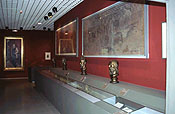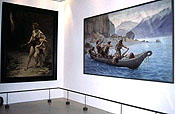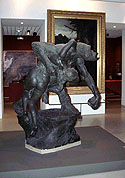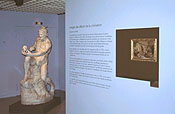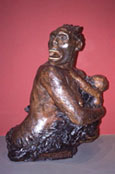The browser will either open the file, download it, or display a dialog.
|
"Vénus et Caïn: Figures de la Préhistoire, 1830–1930" Vénus et Caïn: Figures de la Préhistoire, 1830–1930 |
|||||
|
"Venus and Cain: Figures of Prehistory, 1830–1930" brought together a treasure trove of images of the prehistoric past, most of which were reproduced in the lavishly illustrated accompanying catalogue. Although working with a limited two-story space, the organizers at the Musée d'Aquitaine in Bordeaux produced an aesthetic and educational show that, among other things, served to spotlight the museum's permanent prehistoric collection in a new way. Informative labels and wall texts served to elucidate both the objects on display and the exhibition's main themes. At the same time, a variety of correspondences operated among the exhibited works, rewarding the attentive viewer with insights about the interplay of art and science. | |||||
| The three principal themes of the exhibition were the invention of prehistory, the collaboration between artists and scientists in reconstructing the prehistoric past, and the creation of prehistoric fantasies, as discussed by Hélène Lafont-Couturier, the museum's curator, in her introductions to the corresponding sections of the catalogue. The first room on the ground level, as well as several catalogue essays, addressed the development of prehistory and the role that Aquitaine played in that process (fig. 1). Highlights included busts of celebrated prehistorians (fig. 2) and flint tools excavated by Jacques Boucher de Perthes, who is commonly considered the "father of prehistory." Meanwhile, the interaction between artists and scientists was arguably best seen in the adjacent area that included painted plaster busts (fig. 3) created between 1909 and 1914 by Belgian sculptor Louis Mascré. These works were created in conjunction with Aimé Rutot, the curator at the Institut Royal des Sciences Naturelles de Belgique in Brussels where the sculptures are still housed, as discussed in Anne Hauzeur and François Mairesse's catalogue essay "An Exemplary Collaboration: Louis Mascré and Aimé Rutot." While the coloration of these busts was a revelation, as they are primarily known through black-and-white reproductions, the inclusion of some of the sculpted fossil skulls that the two men produced to aid them in their reconstructions was particularly useful in elucidating their working methods (fig. 4). Also pertinent to the issue of collaboration was the reproduction in the catalogue of anthropologist, archeologist, and physician Louis Capitan's 1903 necrological article that discusses how painter Paul Jamin, four of whose works are in the exhibition, consulted with Capitan in creating his scenes of prehistory. While a case could be made that even the most scientifically informed depictions included their fair share of imagination, other representations fall more solidly in the fantastical category. Such images appear throughout the exhibition, but there is a concentration of them on the second floor, where the show terminates with fictional film clips, including Charlie Chaplin in His Prehistoric Past (1914). | ||||||
|
Sections of the exhibition were truly inspired, such as the central gallery downstairs filled with several large-scale canvases and designed to allude to the Paris Salon (Fig. 5). While it was a treat to see Léon Maxime Faivre's two major prehistoric images, The Invader (1884; Musée des Beaux-Arts et d'Archéologie, Vienne) and Two Mothers (1888; Musée d'Orsay, Paris) side by side, placing this pair in close proximity to Emmanuel Benner's The Lookout (1879; Musée Petiet, Limoux), Angèle Delasalle's The Return from the Hunt (1898; Musées de la Ville de Poitiers et de la Société des Antiquaires de l'Ouest, Poitiers), and Paul Jamin's Abduction in the Bronze Age (1900; Musée Saint-Remi, Reims) provided visitors with a glimpse of what the Salon must have looked like in the late nineteenth century and demonstrated the almost continuous presence of paintings of prehistory at the Salon at that time. Moreover, there was an instructive wall text discussing the role of the Salon for those without a background in the history of art of this period. | |||||
| The central focus of this faux Salon was Emmanuel Fremiet's patinated plaster Gorilla Carrying Off a Woman (1887; Fonds National d'Art Contemporain, Puteaux; consigned to the Musée des Beaux-Arts de Nantes) (fig. 6). This sculpture was complemented by a wall of Fremiet memorabilia (fig. 7), including a poster for one of his animal drawing classes (1896; Bibliothèque Centrale du Muséum National d'Histoire Naturelle, Paris). While interest in the great apes and fascination with prehistoric humans certainly intersected in the nineteenth century—as evidenced by the exhibited letter (undated; Collection Frits Lugt, Institut Néerlandais, Paris) in which Fremiet refers to his sketch of a gorilla as "the exact portrait of Adam," suggesting that the first man was simian in appearance—Fremiet's Gorilla is not truly a "figure of prehistory" in keeping with the exhibition's overall focus. In fact, Fremiet's letter may well have been produced tongue in cheek, as evidence suggests that he was a firm anti-evolutionist who believed that prehistoric humans very closely resembled modern ones.1 Consequently, it would have been more apropos to have displayed one of his undisputed prehistoric works, such as Man of the Stone Age or Bear-Cub Thief (1872 and 1885, respectively; Muséum National d'Histoire Naturelle, Paris), photographs of which were included on the sculpture's pedestal. Moreover, because Fremiet is so closely associated with Stone Age imagery, a catalogue essay devoted to him would have been appropriate. Such a consideration of Fremiet's work might have clarified the exact nature of the relationship he perceived between the prehistoric humans and the great apes that he repeatedly sculpted. | ||||||
| The upstairs section devoted to images of prehistoric artists was extremely well conceived and executed. The accompanying wall text was situated next to Paul Jamin's study for Painter Decorator of the Stone Age (1903; private collection, Paris) (Fig. 8), an important inclusion as this image, produced almost immediately after prehistoric parietal art had been recognized by the French scientific community, was the first painting of a prehistoric painter. This section also included Paul Richer's plaster First Artist (ca. 1890; Musée Crozatier, Le Puy-en-Velay) and Mascré and Rutot's The Magdalenian Artist of the Cro-Magnon Race (Fig. 9) and Negroid of Menton (Fig. 10), each of which depicts a Paleolithic sculptor gazing intently at the portable art object he holds in his left hand while holding a stone tool in his right. Striking visual parallels operate among these representations of Stone Age sculptors, and it is doubtful that Richer and Mascré would have produced such similar images if left completely to their own devices and speculation. It seems more probable that Mascré was influenced by Richer's sculpture or that both artists drew on a common artistic prototype.2 Thus, while claiming to be scientific and to be extrapolating from established evidence, artists who reconstructed prehistory often owed their largest debt to other works of art. | ||||||
| Perhaps most interesting was the chapel-like space created to showcase the museum's Laussel Venus with Horn and works inspired by this masterpiece of prehistoric art (Fig. 11). Dramatically illuminated at the far end of a dimly lit alcove, this Gravettian bas-relief was flanked by two of Mascré and Rutot's sculptures: the Negroid of Menton, discussed above and depicting the supposed artist of this work, and Negroid Woman of Laussel, representing the hypothetical model. The figures, both "negroid" in appearance, demonstrate the intersection of art with contemporary anthropological beliefs. As Sigolène Loizeau notes in her catalogue essay "Laussel: A Face for a Venus," the characteristics of certain prehistoric fossils as well as the resemblance of the Laussel Venus to the so-called Hottentot Venus led scientists in the early twentieth century to conclude that members of a "black race" had created, and were depicted in, such Paleolithic images. | ||||||
| In addition to being a major motivation behind the exhibition's title, or at least the feminine half of it, the Laussel Venus provided "Venus and Cain" with an important focal point that allowed for renewed attention to the Musée d'Aquitaine's permanent collection. Throughout the exhibition, a variety of prehistoric artifacts from the museum's holdings, including tools, weapons, and jewelry, were juxtaposed with this and other "figures of prehistory." While illustrating the richness of the collection, these prehistoric vestiges also underscored the symbiotic relationship between such objects and depictions of the Stone Age. Authentic prehistoric fossils and artifacts validated the artistic representations that referenced them, while artists' renderings of earliest times established a context for such vestiges by bringing the past to life. | ||||||
| In terms of the exhibition title's reference to Cain, Léon Perrault's painting The First Murder (1899; Musée de la Ville de Poitiers et de la Société des Antiquaires de l'Ouest, Poitiers) was included, while Fernand Cormon's Cain (1880; Musée d'Orsay, Paris) was represented by a small reproduction. In general, the title evoked the degree to which the early study of prehistory was informed by both mythology and the Bible and by a desire to reconcile new knowledge with received wisdom. However, little attempt was made to signal the similar way in which artistic precedents served as a basis for much of the art on display, including Jamin's Abduction, which is a rendition, set in the Bronze Age, of numerous mythological rape scenes. | ||||||
| There were other instances in the exhibition where the artistic context of certain works was insufficiently developed. To give just one example, more attention was given to the scientific import of Mascré and Rutot's busts than to the artistic lineage of Mascré's more "creative" bronze Return of Hunt (undated; Collection de l'État Belge, Brussels; loaned by the Communauté Française de Belgique) (fig. 12) and The Troglodytes (ca. 1909; Musée des Beaux-Arts, Tournai) (fig. 13), both of which are strikingly reminiscent of Camille Claudel's small-scale sculptures. On the other hand, the catalogue essay "Prehistoric-Style Nudes" by Katia Busch provided a wealth of contextual information regarding the photographs (1905–08; Vérascope Richard, Photothèque Hachette, Paris) by Achille Lemoine of women scantily clad in fur and posed in "Stone Age" settings that were shown on the second floor. Such imagery clearly foregrounds the fact that prehistory was often a pretext for displaying female nudity. | ||||||
|
The stereographs required to obtain the desired three-dimensional effect of Lemoine's photographs were installed inside rectangular containers on metal poles reminiscent of cattails (fig. 14). Characteristic of the overall installation by architect Françoise Bousquet and designed to recall the watery environment in the nearby images of Neolithic lake-dwelling villages and their inhabitants—such as Albert Anker's Lake-Dwelling Woman (1873; Musée des Beaux-Arts, La Chaux-de-Fonds) and Lake-Dwelling Man (1886; Kunstmuseum, Winterthur) (fig. 15)—the stylized cattails were creative but distracting, with the artistry of the containers somewhat diminishing the impact of the images they contained. Similarly, while the cave-like space constructed near the entrance to the exhibition set an appropriate mood, the accompanying soundtrack of dripping very quickly became annoying. Other aspects of the installation, however, such as the children's game area constructed of boulders (Fig. 16) and the branches used in the display of illustrated menus for dinners in honor of prehistorian Gabriel de Mortillet (Collection Claude Blanc, Le Bugue) (fig. 17) actually enhanced the visual interest of the exhibition. | |||||
| In the end, the most relevant display technique was the presentation of the plaques of prehistoric objects (Collection Vallade, Musée d'Angoulême) lining one of the downstairs walls. This arrangement showed how such artifacts were displayed at the time of their initial discovery and classification, with objects being depicted with like objects in decorative patterns. Underscoring the importance of comparative techniques to prehistory, the plaques encouraged visitors to take a similar approach and seek connections among the various exhibited works. For example, Mascré and Rutot's Woman of the Neanderthal Race (fig. 18) and Faivre's Two Mothers demonstrate an emphasis on mothers who, despite their marked physical differences, are both intent on protecting their children. Concomitantly, Faivre's human mother has a hairstyle that is almost identical to that of Richer's Paleolithic sculptor, as both artists drew on remains found in the sepulchers at Menton and Laugerie-Basse. | ||||||
| After opening in an archeology museum in Bordeaux, the exhibition traveled to Altamira, where there is a new museum associated with the eponymous painted prehistoric cave. The exhibition's final stop was the recently renamed Musée National des Beaux-Arts du Québec. As reflected in the variety of venues, as well as in the catalogue contributions by art historians, archeologists, and historians of science, the exhibition as a whole, like the works on display in it, held both artistic and scientific value. | ||||||
| Maria P. Gindhart Assistant Professor of Art History Georgia State University, Atlanta |
||||||
|
1. See Maria P. Gindhart, "The Art and Science of Late Nineteenth-Century Images of Human Prehistory at the National Museum of Natural History in Paris," dissertation, University of Pennsylvania, 2002, 110-112. 2. One example is the illustration by Pierre Joubert on page 22 of the children's book Les hommes de la préhistoire by Jean-Laurent Monnier (Rennes: Editions Ouest-France, 1992).
|


